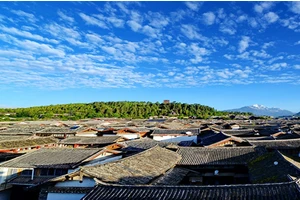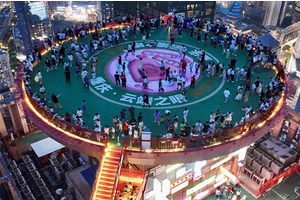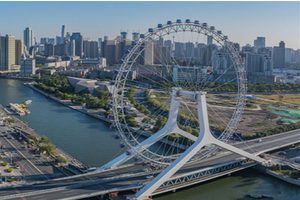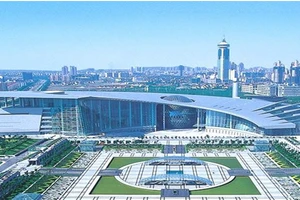Top ten tourist attractions in Anpu
1. Tourist attractions in Lianjiang City, Guangdong Province
Top ten tourist attractions in Zhanjiang
1. Huguangyan
Huguangyan Scenic Spot is a national scenic spot, a national geological park, a national AAAA-level tourist attraction and a national popular science education base for young people. It is located 18km southwest of Zhanjiang City, the southernmost tip of Chinese mainland, and is called a "natural yearbook" by United Nations geological experts to study the earth and geological sciences. Huguangyan, which was formed about 200,000 years ago, is one of the three existing volcanic lakes in China and the only remaining Maar Lake in the world except Manderscheid in Germany. The geological features here include coastal landforms, structural geological landforms and other geological relics, and the natural scenery is excellent. Comrade Dong Biwu once summed it up in ten words: "Four mountains surround a lake, and the lake is as bright as a mirror".
It's hard to find ancient trees in the park, Gu Teng is surrounded with lush vegetation, and there is a high-density negative air ion area, which can be called "natural oxygen bar". People walking by the lake feel relaxed and happy.
2. East Island
East Island is a large flat and open island with an area of 286 square kilometers, ranking fifth in the country. With a population of about 150,000, the island traditionally makes a living by fishing in the sea and planting dry land crops such as coffin potatoes, sweet potatoes, sugar cane and peanuts. In recent years, the cultivation of vegetables transported to the north and the cultivation of lobsters, abalone, prawns, crabs, roes and precious fish have gradually risen to the main business. Fruits include bananas, mangoes, tree pineapples, etc. "Donghai Melon" is a local specialty, shorter than ordinary cantaloupes, still like apples, also known as "apple melon", sweet and crisp. The east coast of East Island faces the vast South China Sea, and there is a clean beach stretching for 28 kilometers, which is the longest beach in China, ranking second in the world after the Australian Gold Coast. The bay is crescent-shaped, with fine and white sand, and it is a good place for tourism and holiday.
3. Sea-watching Corridor
There are two sea promenades, one on the east side of Xiashan downtown and the other on the seashore of Chikan Bay. It is a coastal strip-shaped seaside park invested and built by the municipal government in recent years. The promenade is lush with green grass, fragrant colors, strange trees and dense clumps, forming a garden promenade with varied landscapes, which has become Zhanjiang people's favorite leisure world and a must-see city scenery for foreign tourists. Walking on the promenade, talking and playing games on the grass, the waves are jumping, the sea breeze is blowing, the waves are crossing the sea, and the clouds are floating in the sky, which is really comforting.
4. Inch Jinqiao Park
Inch Jinqiao Park was founded in 1958, formerly known as "Xishan Park" and "People's Park", also known as "Inch Golden Park", which was renamed to commemorate the people's anti-French struggle in Suixi. Inch Jinqiao Park is located in the west of Chikan District, Zhanjiang City, Guangdong Province. Inch Jinqiao Park is named after its proximity to Inch Jinqiao. In 1961, Guo Moruo went to Zhanjiang to inscribe the poem "One inch of rivers and mountains and one inch of gold". The name of the "Golden Bridge" contains the meaning that China's land is not allowed to be occupied by foreign enemies, in order to commemorate the heroic deeds of the people of Zhanjiang in the anti-French struggle in 1898. The statue of the anti-French hero stands in the central square of the park, which is the largest subtropical garden-style park in Zhanjiang.
5. South Asia Tropical Botanical Garden
Zhanjiang South Asia Tropical Botanical Garden, located near Huguang Rock in Zhanjiang City, is a unit integrating scientific research, popular science tourism and development under the Chinese Academy of Tropical Agricultural Sciences. It is an important comprehensive scientific research base for crops in southern subtropical China. It has been engaged in the introduction, development and utilization of tropical plants for a long time. Its rich scientific research achievements and rich tropical plant germplasm resources have made it a popular science education base in Zhanjiang City and even Guangdong Province, and one of the eight scenic spots in Zhanjiang.
6. Techeng Island
Techeng Island is a small island in the middle of Zhanjiang Bay waterway in Zhanjiang City, Guangdong Province. "Techeng" is an ancient Vietnamese language, "Techeng" means place, and "Cheng" means harmony and auspiciousness. It is only 3 nautical miles away from xiashan district, Zhanjiang City, with an area of 36 square kilometers, which is a good natural harbor against the wind and keeps it safe. The island has flat terrain, fresh air and beautiful scenery, and the climate is like spring all the year round. There are more than 500 mu of mangrove forests under special state protection, Xiantai Temple with a history of more than 400 years, and the former site of the Anti-Japanese Revolution. White sand beaches, volcanic rocks, the sea, seagulls, fishing boats and sea pickers set off each other like a colorful oil painting, which makes people linger.
7. Naozhou Island
Naozhou Island, known as Weizhou in ancient times, is an island formed by submarine volcanic eruption about 200,000-500,000 years ago. It is also the largest volcanic island in China. It is located about 40 kilometers southeast of Zhanjiang City, Guangdong Province, with the east island in the north, leizhou bay in the west, the South China Sea in the southeast and the Pacific Ocean in the depth, with a total area of about 56 square kilometers. Naozhou Island is one of the "Eight Scenes of Zhanjiang", which is called "the ancient rhyme of Naozhou". There are many scenic spots and historical sites on the island, including Nayanhai Stone Beach, a tourist resort in the south of China, an ideal natural bathing beach, and Weizhou Lighthouse, one of the three world-famous lighthouses, which is as famous as London and Cape of Good Hope Lighthouse. It is an island outside Zhanjiang City, with beautiful scenery and pleasant climate all year round.
8 Jizhaowan
Jizhaowan is located in Wuchuan City, Guangdong Province, 50 kilometers east of Zhanjiang City, with a coastline of 11.2 kilometers. It is a beautiful coastal tourist resort. In the tourist area, the sea is vast and the water is blue, the beach is broad and the forest is dense, the climate is mild and the aquatic products are abundant. There are ten miles and nine bays, one bay and one scene, with beaches, sandbars, rocks, rivers, lakes, harbors, forests, fishing villages, rows of sunflower trees and coconut palms, which are very subtropical coastal features.
9. Tianchengtai, Wushi Town, Leizhou
Tianchengtai Resort is located in Beiquan Beach on the right side of Wushi Port, Wushi Town, Leizhou City, Zhanjiang, covering an area of more than 200 mu. It is a natural island with convenient transportation and pleasant scenery. Tianchengtai Tourist Resort is the southernmost seaside tourist resort in mainland China. It is close to the Beibu Gulf and surrounded by the sea on three sides. It has more than 4 kilometers of golden beaches, clean and moist sand, coconut wind and sea charm, blue sea and blue sky. There are large living corals on the seabed nearby. The layout and architecture of the whole resort not only reflect the roughness of Nanhai fishing village, but also have the exquisiteness of Jiangnan gardens.
10. Guangdong Ocean University
Guangdong Ocean University, formerly known as Zhanjiang Ocean University, is located in Mazhang District, Zhanjiang City. Ocean University has a large area. It is recommended to take the school bus around the campus. The campus has the most complete museum of aquatic products in China-Ocean Museum, where you can see nearly 3,000 kinds of aquatic organisms, including whales, fish, shellfish and algae, which is amazing and amazing. Guangdong Ocean University is close to Huguangyan. Visitors can go to Huguangyan after visiting the campus of Haida University and appreciate the unique features of the Geopark.
2. What are the tourist attractions in Lianjiang City, Guangdong Province?
A: There are Gao Qiao Mangrove Reserve, Dinglongwan International Ocean Resort, Luogang Town, Longhaitian Island Tourist Area and Huguangyan Scenic Area.
3. Lianjiang scenic spot tourist attractions
Introduction: Lianjiang No.18 Primary School is located in the east of Meijing South Road (that is, the east of Meijing International Plaza). It is a complete primary school built by Lianjiang Municipal Party Committee and Municipal Government according to the provincial standardized school standards, with a total investment of 30 million yuan. The scale of running a school is 1800 students, with six classes at each level, with an average class size of 50 students. The campus covers an area of 18.8 mu with a building area of 13,500 square meters. The campus environment is first-class, the layout is scientific and reasonable, and the functional rooms are complete. There are 36 high-standard classrooms, and each classroom is equipped with a multimedia audio-visual platform. The hardware of the school is the best among the primary schools in the city, and it is the only primary school in the city with a 200-meter circular plastic track playground. The school's leading group has both ability and political integrity, is in the prime of life, has rich experience in education and teaching management, and has a strong faculty. The first batch of teachers selected outstanding teaching elites from No.1 Primary School to No.7 Primary School in the city. Registered capital: RMB 23 million.
4. What are the famous tourist attractions in Lianjiang City, Guangdong Province?
Lianjiang has three major seafood ports, Anpu Jiuyu Fishing Port, Yingzai Fishing Port and Cheban Longtousha Fishing Port.
Among them, on June 24th, 1994, the provincial people's government approved Yingzai Port in Lianjiang as an open port, and now Yingzai Town has unique coastal tourism resources, including ten thousand mu of contiguous mangroves, Changhong Wobo Longyingwei levee, Wantian Shrimp Pond and other scenic spots, which is a good place for leisure travel, sightseeing and entertainment!
5. What are the tourist attractions in Lianjiang, Guangdong?
Lianjiang City has beautiful mountains and waters and beautiful scenery. The natural landscapes formed in history include "Eight Scenes of Shicheng", namely, the overlapping mountains, the heavy clearance of Qiling, the dragging practice of Shuangxi, the Sanhe Hot Spring, the verdant scenery of Wenfeng, the stone chambers, the ancient state of Longhu and the Shijing of Song Ming. The new sights include: Santai Yuanwang, Park Chunhui, Shijiao Rainbow, Shuangfeng Songtao, Evergreen Orange Red, Crane Lake Yanyu, Jiuzhou Qinyun, Longying Wobo, Shili Mangrove and Nanbei Avenue. These scenic spots are beautiful and full of weather, and Chinese and foreign tourists come here in an endless stream. These tourist attractions are the potential of Lianjiang to develop tourism. Lianjiang's tourism industry has begun to take shape. For example, the Hedi Reservoir, known as the "misty rain in Hehu Lake", has a square garden of more than 140 square kilometers and a storage capacity of 1.2 billion cubic meters. Looking around, you can see the blue waves rippling and the sky is high and wide. Water and sky are the same color, endless, really worthy of being called "man-made sea" There are many green islands in the middle of the reservoir, just like pearls embedded in a green carpet, which adds beauty. Every autumn evening, the setting sun shines obliquely, the sky is clear and the water is clear, and the cranes fly and dance in the depths of the reservoir. It's really beautiful that "the autumn water grows together and the sky is the same, and the sunset and the crane Qi Fei". Visitors can go boating around the lake, enjoy the scenery, explore the whereabouts of white cranes, and send their feelings between the mountains and rivers; You can bathe and wash in the lake, and the fatigue and troubles between the secular people go away with the cool water, which makes people forget to leave the world! Or hit the water in the middle stream and pay for your ambition; You can also board the Youth Pavilion and overlook it by the railing, enjoying the boundless scenery of Crane Lake with rippling blue waves, vast smoke waves and boundless Tianshui.There are recreational facilities such as water speedboat, water bike, seaplane, bumper boat, bumper car, air gun shooting, Kangle ball, electronic games, etc. at the beginning of the reservoir canal. When you come back from the lake, you can walk in the Woods, fish by the lake, or enjoy yourself in the casino. Lianjiang Red Orange is a high-quality citrus product selected and cultivated by the state-owned Hongjiang Farm in this city in 1970s (Hongjiang Farm called it Hongjiang Orange). According to the national and provincial experts' appraisal, the variety source of Lianjiang Red Orange is the mosaic (fan-shaped) variant when Luojiang Liutian Orange and Jiangxi Red Orange are grafted. Only under the specific geographical location, soil, climate conditions and cultivation techniques of Lianjiang, its special excellent characters and quality are shown. It is well-known at home and abroad for its excellent color, fragrance and taste, and won the title of national high-quality fruit, which was designated as "a good fruit of state banquet", and Lianjiang City was also named "the hometown of red oranges in China" by the state. Lianjiang Minghuang Tea is recognized and loved by consumers for its safety, high quality and unique taste. Based on the concept of "nature, green and health", relying on science and technology, aiming at the soil rich in rare trace elements in the base, a unique management regulation of organic tea planting with environmental protection, safety and ecology is formulated: pesticides and fertilizers are strictly prohibited. Fertilization-only apply bio-organic fertilizer formulated by food experts: mixed fermentation of peanut bran and bio-organic liquid, and never use chemical fertilizer; Pest control-plant control is the main method, supplemented by biological control, and pesticides are strictly prohibited. Tea-making technology-With South China Agricultural University and other scientific research institutions, we have collected traditional tea-making technologies from mainland China and Taiwan Province, and after years of repeated research, we have innovated a unique new oolong tea technology.Red carambola is also called carambola, or it can also be called carambola, carambola, etc. Lianjiang belongs to the subtropical monsoon climate, with an annual precipitation of more than 6000mm. The location of carambola ditch is surrounded by mountains on three sides and facing the sun in the lee, with an average annual temperature of about 22 degrees, which is the most suitable production area of carambola, so it tastes especially crisp and sweet, and its taste is more crisp. Lianjiang City is outstanding in people and beautiful in mountains. In 1995, it was awarded the title of "Hometown of Red Oranges in China" and "National Sanitary City", in 1996 it was awarded the title of "National Top 100 Afforestation Counties (Cities, Districts)", in 2001 it was awarded the title of "Advanced Cultural City in South Guangdong" and "National Advanced County (City, District) for Marriage and Childbearing Activities" by the provincial government, and in 2004 it was awarded the title of "National Advanced County (City, District)". In addition to red orange, Lianjiang successively won the titles of national green food such as Guang Hai chicken, Minghuang tea, Meizhan tea, carambola and Guangliang red litchi.
6. What are the scenic spots in Lianjiang City, Guangdong Province?
Lianjiang Shili Silver Beach is located in Hailing Island, Yangjiang City, Guangdong Province. It has beautiful scenery and is rugged and magnificent. It is connected with Shijiao Beach into a spiral shape, surrounded by mountains on three sides, with a total length of 9.7 kilometers and a coastline of 16.5 kilometers. It has Shili Silver Beach, which is listed in the Guinness Book of World, and the largest imitation song building complex in China-Song Cheng, National Villa and Yinhai Mountain Villa.
Nanhai No.1, discovered by archaeologists, is also displayed to the public at the Guangdong Maritime Silk Road Museum in Shili Yintan Scenic Area, which can be said to be a fun beach.
7. Attractions in Lianjiang City
The ancient city of Maodegong is surrounded by: Leiwang's hometown (Leizu Temple), Leizhou West Lake Park, Leizhou Sanyuanta Park "Red-billed Gull" Zhanjiang Harbor Tour, Jinshawan Coastal Leisure Tourism Zone, Huguangyan Scenic Area, the First Geopark of China, Sanlingshan National Forest Park, Hedi Yinhu National Water Conservancy Scenic Area, South Asia Tropical Botanical Garden, Lianjiang Red Orange Base, Xuwen "Pineapple Sea" and so on.
8. Introduction of tourist attractions in Lianjiang City, Guangdong Province
Lianjiang, one of the top ten reservoirs in China, is located in the southwest of Guangdong Province, in the north of Leizhou Peninsula, adjacent to Beihai City in Guangxi in the west and Beibu Gulf in the southwest, with an area of 2,835 square kilometers. It now governs 22 towns with a population of 1,486,500. The city is a cheap town with a built-up area of 13 square kilometers and a population of 117,000. The terrain is high in the northeast and low in the southwest, and the Shuangfeng peak at an altitude of 382 meters is the highest point in Zhanjiang. The main rivers are Kyushu River, Shachan River, Wuling River and Lianjiang River, with a coastline of 75 kilometers. The territory is rich in resources, and the bankruptcy resources are in Zhanjiang. The reserves of gold, silver and granite rank among the best in Guangdong, and it is known as the "Kingdom of Granite Shore". Lianjiang Qin belongs to Xiang County, and Han belongs to Hepu County. In the 5th year of Tang Wude (622), Shicheng County was founded. In the 1st year of Tianbao (742), it was renamed Lianjiang County. In the 3rd year of Southern Song Dynasty (1176), Wuchuan Xixiang was located in Shicheng County. In the 3rd year of the Republic of China (1914), Shicheng County was changed to Lianjiang County. After liberation, it belonged to Guangdong South Road Commissioner's Office successively. In 1983, it was changed to the system of city leading county, which was under the jurisdiction of Zhanjiang City. In 1993, the county was removed to set up a city (county level). In 1995, Lianjiang City was classified as a second-class city by the province, and now it is managed by Zhanjiang City. Lianjiang has convenient transportation, 48 kilometers away from Zhanjiang Port and Zhanjiang Airport. Railway Lizhan Line and Guangzhan Line, Highway 207 national highway and National Highway 325 run through the territory, and have formed a highway network with the urban area as the center and the national, provincial and municipal roads as the skeleton to radiate to towns. Maritime transportation is convenient, and the three ports of Anpu, Yingzai and Longjuesha are not more than 160 nautical miles away from Haiphong and Hongji Port in Vietnam.The annual throughput capacity is 600,000 tons. With sufficient water and electricity, every village has access to telephones. In 1992, the Municipal Post and Telecommunications Bureau was rated as one of the top 100 county posts and telecommunications bureaus in China. In 1998, Lianjiang was rated as a national health city for three consecutive years. Lianjiang is a coastal open area in China. The rural areas have strong comprehensive strength. In 1991, they were rated as the top 100 counties with comprehensive strength in China. In 1994, they were rated as the top 100 counties (cities) with total output of agriculture, forestry, animal husbandry and fishery, total output of pigs, beef and mutton, total output of aquatic products, total output of fruits, total output of sugar and agricultural added value. In 1995, they were rated as the top 100 counties (cities) with national forestry greening. Township enterprises have developed rapidly, with 17,487 existing township enterprises. There are complete industrial categories, and 10 production bases such as building materials, cigarettes, sugar, ceramics, textiles, beverages, household appliances, machinery, leather plastics and automobile assembly have been formed. The main industries are building materials, sugar and cigarettes. In 2001, the city's GDP was 6.328 billion yuan, with an average annual growth rate of 8.0% during the Ninth Five-Year Plan period. The main places of interest are: Hedi Reservoir-the largest "man-made sea" in the province; Longyingwei ten thousand mu shrimp pond-the largest contiguous shrimp farm in Southeast Asia; Mangrove Nature Reserve-the largest mangrove forest in Chinese mainland at present; Luozhou ancient city ruins-an important site to study the social features of western Guangdong in Tang Dynasty. The most distinctive folk culture is Anpu Bayin and Dragon Boat Race. However, there are "Eight Scenes of Shicheng", namely, the mountains are stacked, the Qiling Pass is heavy, the Shuangxi Tulian, the Sanhe Hot Spring, the Wenfeng Mountain is verdant, the stone chambers are piled up, Longhu Guzhou and Song Ming Shijing.The new sights include: Santai Yuanwang, Park Chunhui, Shijiao Rainbow, Shuangfeng Songtao, Evergreen Orange Red, Crane Lake Yanyu, Jiuzhou Qinyun, Longying Wobo, Shili Mangrove and Nanbei Avenue. These scenic spots are beautiful and full of weather, and Chinese and foreign tourists come here in an endless stream. These tourist attractions are the potential of Lianjiang to develop tourism. Lianjiang's tourism industry has begun to take shape. For example, the Hedi Reservoir, known as the "misty rain in Hehu Lake", has a square garden of more than 140 square kilometers and a storage capacity of 1.2 billion cubic meters. Looking around, you can see the blue waves rippling and the sky is high and wide. Water and sky are the same color, endless, really worthy of being called "man-made sea" There are many green islands in the middle of the reservoir, just like pearls embedded in a green carpet, which adds beauty. Every autumn evening, the setting sun shines obliquely, the sky is clear and the water is clear, and the cranes fly and dance in the depths of the reservoir. It's really beautiful that "the autumn water grows together and the sky is the same, and the sunset and the crane Qi Fei". Visitors can go boating around the lake, enjoy the scenery, explore the whereabouts of white cranes, and send their feelings between the mountains and rivers; You can bathe and wash in the lake, and the fatigue and troubles between the secular people go away with the cool water, which makes people forget to leave the world! Or hit the water in the middle stream and pay for your ambition; You can also board the Youth Pavilion and overlook it by the railing, enjoying the boundless scenery of Crane Lake with rippling blue waves, vast smoke waves and boundless Tianshui. There are recreational facilities such as water speedboat, water bike, seaplane, bumper boat, bumper car, air gun shooting, Kangle ball, electronic games, etc. at the beginning of the reservoir canal. When you come back from the lake, you can walk in the Woods, fish by the lake, or enjoy yourself in the casino.The beautiful Yushu Palace in Anpu Town, Lianjiang City, the original mangrove reserve in Lianjiang People's Park, one of the top ten reservoirs in China, and the Wenyuan Pagoda on the banks of Jiuzhuzhou River are antique.
9. Tourist attractions in Lianjiang City
1. Recommended reason for Zhanjiang Mangrove National Nature Reserve: China's largest coastal mangrove wetland is inhabited by many protected animals, and it is also a stop for international migratory birds. 2. Hedi Reservoir 3. Geling Village Recommended reason: The village in the old revolutionary area was rated as one of the "most beautiful villages in Zhanjiang" with its unique beauty and cultural precipitation. 4. Tangshanling Ecological Park 5. Xiexie Mountain 6. People's Park 7. Tianyang Famous Liquor Store 8. Chenguang Farm Team 6.
Tourist attractions in Anpu Town:
I. Zhongshan Park
Zhongshan Park, which should be the earliest place for Anpu people to play and relax, is said to be built in memory of Dr. Sun Yat-sen. It's at the intersection at the end of Anpu 30-meter Street. In recent years, with the support of the local government and relevant people, the park has taken on a new look, adding an indoor ball room, an open-air court, a chess room, a music fountain and so on. It is a very good leisure place.
Second, the street park
Street Park, which is a few hundred meters south of Zhongshan Park and opposite to Anpu Station, is a very small park. Although it is less than 100 square meters, it is very beautiful, especially in the yellow light.
Third, Wenge Tower
Wenge Tower, which is far to the west of Street Park and located on the banks of Jiuzhou River, is not open to the public at ordinary times. At night, the outline lights of the building will be turned on, which is quite attractive from a distance. I heard that it will be renovated recently and some related buildings will be added. It's really exciting!
Fourth, the river promenade
After coming out of the north gate of Zhongshan Park, walk west to the underground of Xinqiao and you can see it. In the southwest of the corridor, you can see the Wenge Tower standing tall, in the west, you can see a amorous feelings street, and in the north, there are Anpu Guanyin Temple and Zizhu Temple.
V. Anpu Cultural Square
Anpu Cultural Square, located in the center of the town, tens of meters east of Street Park, also offers several paid play items, most of which are played by children. In addition, there is an exclusive stage where rehearsals and performances are usually held, and some grand events are also held here. For example, the opening and closing ceremonies of Anpu Food Festival are held here every year from the first day to the seventh day of the first lunar month.






